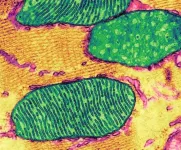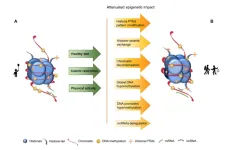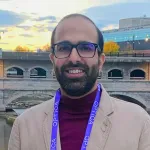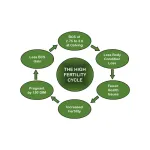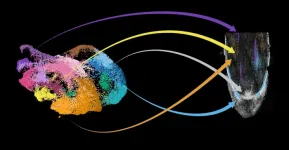(Press-News.org) In medicine and science, the term “pathogenesis” describes the origin and development of disease. There is not, however, a broadly accepted term to describe the other half of the equation: the process of healing and recovery.
In a new and far-reaching paper, published May 10, 2023 in the journal Mitochondrion, Robert K. Naviaux, MD, PhD, professor of Medicine, Pediatrics and Pathology at UC San Diego School of Medicine, proposes both a term and, more importantly, outlines the array of processes and players, beginning with cellular mitochondria, that drive the healing process – and whose dysfunction underlies chronic illnesses from diabetes and autoimmune disorders to long COVID and autism spectrum disorder.
“Great strides in medicine since World War II have focused on and addressed the triggers and risk factors of disease,” said Naviaux. “This pathogenesis-based approach has been very effective in developing treatments for acute illnesses, such as those caused by physical trauma, infection, vitamin deficiencies and poisoning.”
The greater health threat now, he said, lies with chronic disease. Six in 10 adults in the United States have a chronic disease; 4 in 10 have two or more. These conditions, such as heart disease, cancer, diabetes, Alzheimer’s and chronic kidney failure, account for 7 out of 10 deaths in the U.S. each year, according to the Centers for Disease Control and Prevention.
“In the last 70 years, not a single chronic illness is curable using current medical paradigms unless it has a cause that can be bypassed, killed, burned out or cut out,” said Naviaux.
“When cures are achieved, they rely on recovery by spontaneous healing — an essential process that operates silently in the background and is still poorly understood. Antibiotics can cure a pneumococcal pneumonia and a stent can reopen an occluded (blocked) coronary artery, but active healing is required after the intervention to repair the damaged lung and heart.
“Without healing,” said Naviaux, “multicellular life on Earth would not exist. Without healing, one injury predisposes to another, leading to disability, chronic disease, accelerated aging and death.”
“In most cases, pathogenesis-based drugs like insulin for diabetes and statins for dyslipidemia (an imbalance of blood lipids, such as cholesterol, that leads to cardiovascular disease) must be taken for life because the root cause of the chronic symptoms is not changed by treatment.”
In his new paper, Naviaux posits that the root cause of many chronic diseases lies with disruption in the normal sequence of mitochondrial transformations needed to initiate and complete the healing cycle. He has called this universal response to infection, stress, or injury, the cell danger response or CDR. The CDR is an evolutionarily conserved metabolic response that protects cells and hosts from harm. CDR is triggered by exposure to chemical, physical or biological threats. It is a normal part of the immune response that prompts cells to take protective measures.
But sometimes, as Naviaux has shown in past published work, including a ground-breaking preclinical study in 2014, and a seminal Phase 1b/2a Clinical Trial involving young boys with autism published in 2017, CDR continues to sound the alarm even after the originating threat is gone. Inflammation and cell dysfunction persist, resulting in chronic symptoms.
“Abnormal persistence of any phase of the CDR inhibits the healing cycle, creates dysfunctional cellular mosaics, causes the symptoms of chronic disease and accelerates the process of aging,” said Naviaux.
“New research reframes the rising tide of chronic disease around the world as a systems problem caused by the combined action of pathogenic triggers and anthropogenic factors (from human activity, such as pollution) that interfere with the mitochondrial functions needed for healing. Once chronic pain, disability or disease is established, salugenesis-based therapies will start where pathogenesis-based therapies end.”
What is Salugenesis?
Salugenesis derives from the Latin word for the Roman goddess of health, safety and prosperity, Salus. It is related to “salutogenesis,” a word coined in 1976 by the medical sociologist Aaron Antonovsky to describe lifestyle choices and coping skills people use to produce, restore and preserve good health despite all manner of hardship.
Salutogenesis is a sort to big picture concept. Salugenesis is more narrowly focused on the sequential, hard-wired molecular, metabolic and cellular stages of the healing cycle. Both words involve redirecting energy to oppose and reverse the arrow of entropy or decay. They are the opposite of pathogenesis, which is about disorganization and disintegration driven by disease.
Naviaux’s paper makes several key points, among them:
Chronic diseases are currently and mistakenly studied in isolation. Diabetes, for example, looks a lot different from post-traumatic stress disorder. But both, and many other conditions, share an underlying failure of the body to fully heal. “Once the pathogenic trigger has been treated or removed, chronic disease persists because healing is incomplete,” said Naviaux.
Disease is governed by biological logic, which is intrinsic and the result of millions of years of evolution to address internal problems. Modern medicine has advanced through engineering logic, which looks at external issues generally involving non-living systems.
Health and healing are dynamic circles with a beginning, middle and end. The phases are the same whether the injury is a scrape or a stroke. They proceed sequentially by information exchanged between cells and with the environment, directing and informing what happens next. “Mitochondria generate most of the chemical energy needed to power a cell’s biochemical reactions,” said Naviaux. “But they are also cellular canaries in the coal mine, the early warning system that determines the nature and location of a problem or threat, and when to sound the alarm.”
Mitochondria naturally prioritize safety and respond to threats of all kinds—from microbial infections, to physical injury, to chemical pollutants in the air, water, and food chain—by stopping their normal anti-inflammatory functions, and shifting to pro-inflammatory functions needed to contain the damage, replace the cells lost, and finally, to restore normal metabolic communication between cells needed for optimum organ function.
CDR is both alarm and the proportional response to threat, he said. If mitochondria do not function properly — or CDR gets stuck in a phase — healing stops and disease prevails.
Curing chronic disease, according to Naviaux, must account for the fact that all such conditions are systems-wide failures, likely caused by multiple factors. “The same disease can be caused by different things in different people,” said Naviaux. Most diseases involve factors such as multiple genes, infection, environmental or microbial exposures, lifestyle choices and more.
With his work and latest publication, Naviaux argues for development of salugenesis-based research, which would explore the unified biological response to injury, harm and disease. Acute illness, he said, is a temporary state; chronic illness results from the long-term inability to heal completely after an acute injury has passed. They are two sides of the same coin.
Naviaux said he hopes that new research will lead to a “second book of medicine” that will collect new knowledge about the cause and treatment of complex chronic disease viewed through the lens of the healing cycle and salugenesis.
“If healing can be rebooted or unblocked after it has been derailed, cures of disorders once thought incurable may one day be possible,” he said.
# # #
END
The acute problem of chronic disease
In a wide-ranging paper, a UC San Diego physician-scientist explains why all chronic diseases, from diabetes to autism, are linked by the underlying failure of cells and the body to heal completely
2023-05-10
ELSE PRESS RELEASES FROM THIS DATE:
An epigenetic approach to modulating aging with nutrition and exercise
2023-05-10
“In this review, we describe how aging impacts epigenetics and how nutrition and physical exercise can positively impact the aging process, from an epigenetic point of view.”
BUFFALO, NY- May 10, 2023 – A new review paper was published in Aging (listed by MEDLINE/PubMed as "Aging (Albany NY)" and "Aging-US" by Web of Science) Volume 15, Issue 8, entitled, “How can we modulate aging through nutrition and physical exercise? An epigenetic approach.”
The World Health Organization predicts that by 2050, 2.1 billion people worldwide ...
APL Photonics selects recipient for 2022 Future Luminary Award
2023-05-10
MELVILLE, N.Y., May 10 – The University of Arizona’s Husain Alqattan is the recipient of the APL Photonics 2022 Future Luminary Award for his work in utilizing pulse shaping and waveform synthesis to control electron motion and open the door for ultrafast electronics that process data at unprecedented speeds.
The winning paper, “Attosecond light field synthesis,” was published in the April 2022 issue of APL Photonics. In it, Alqattan and his team used an attosecond light ...
Using AI to predict important measure of heart performance
2023-05-10
Coronary heart disease is the leading cause of adult death worldwide. The coronary angiography procedure provides the clinical standard diagnostic assessment for nearly all related clinical decision-making, from medications to coronary bypass surgery. In many cases, quantifying left ventricular ejection fraction (LVEF) at the time of coronary angiography is critical to optimize clinical decision-making and treatment decisions, particularly when angiography is performed for potentially life-threatening acute coronary syndromes (ACS).
Since the left ventricle is the heart’s pumping center, measuring the ejection fraction in the chamber provides critical information about the percentage ...
Bleeding after image-guided breast biopsies: Discontinuing vs. maintaining antithrombotic therapy
2023-05-10
Leesburg, VA, May 10, 2023—According to an accepted manuscript published in ARRS’ own American Journal of Roentgenology (AJR), frequencies of imaging-apparent and palpable hematoma were not significantly different between patients temporarily discontinuing versus maintaining antithrombotic therapy (AT).
“The findings support safety of continuing AT during breast core-needle biopsy (CNB),” wrote lead researcher Melissa Reichman, MD, of Weill Cornell Medicine at New York-Presbyterian ...
Ohio State professor elected to National Academy of Sciences
2023-05-10
COLUMBUS, Ohio - An Ohio State University astronomy professor has been elected to the National Academy of Sciences, one of the highest honors a scientist can receive in the U.S.
David Weinberg, Distinguished University Professor and chair of astronomy, is among 120 new members and 23 international members from 13 countries who were inducted this year in recognition of distinguished and continuing achievement in original research inside their chosen field.
“I have been lucky to have great students and great colleagues throughout ...
New Cleveland Clinic research links immune cell receptors to asthma, inflammatory lung disease
2023-05-10
CLEVELAND - Inhibiting a protein on the surface of immune cells could offer new strategies for treating severe asthma, Cleveland Clinic researchers found.
Researchers discovered a new way a protein called MCEMP1 contributes to severe inflammation in the airway and lungs. The discovery, published in Nature Communications, provides critical information for developing therapeutic interventions to treat long-term lung conditions, including asthma, on a biological level.
The study was conducted in a lab led by Jae Jung, PhD, chair ...
Entangled quantum circuits
2023-05-10
A group of researchers led by Andreas Wallraff, Professor of Solid State Physics at ETH Zurich, has performed a loophole-free Bell test to disprove the concept of “local causality” formulated by Albert Einstein in response to quantum mechanics. By showing that quantum mechanical objects that are far apart can be much more strongly correlated with each other than is possible in conventional systems, the researchers have provided further confirmation for quantum mechanics. What’s special about ...
Simple management steps for a high fertility cycle in your dairy herd
2023-05-10
Philadelphia, May 10, 2023 – The dairy industry has seen a revolution over the past two decades in fertility success within herds. Widely adopted fertility programs are at the heart of this leap forward, along with the industry’s increased understanding—and optimization—of the holistic interactions among the body condition, overall health, and fertility of a dairy cow. In a recent mini-review appearing in a special fertility issue of JDS Communications®, published by Elsevier, researchers from the University of ...
Scientists release a new human “pangenome” reference
2023-05-10
Researchers have released a new high-quality collection of reference human genome sequences that captures substantially more diversity from different human populations than what was previously available. The work was led by the international Human Pangenome Reference Consortium, a group funded by the National Human Genome Research Institute (NHGRI), part of the National Institutes of Health.
The new “pangenome” reference includes genome sequences of 47 people, with the researchers pursuing the goal of increasing that number to 350 by mid-2024. With each person carrying a paired set of chromosomes, the current reference actually includes 94 distinct genome ...
Crops evolved by swapping genetic modules between cells
2023-05-10
Comparing individual cells across corn, sorghum, and millet reveals evolutionary differences among these important cereal crops, according to a new study led by New York University researchers.
The findings, published in Nature, bring researchers closer to pinpointing which genes control important agricultural traits such as drought tolerance, which will help scientists faced with a changing climate adapt crops to drier environments.
Corn, sorghum, and millet provide food for humans and animals around the world. Corn and sorghum are ancient relatives that evolved into two different species roughly 12 million years ago, and millet is a more distant relative.
Despite ...
LAST 30 PRESS RELEASES:
A new way to map how cells choose their fate
Numbers in our sights affect how we perceive space
SIMJ announces global collaborative book project in commemoration of its 75th anniversary
Air pollution exposure and birth weight
Obstructive sleep apnea risk and mental health conditions among older adults
How talking slows eye movements behind the wheel
The Ceramic Society of Japan’s Oxoate Ceramics Research Association launches new international book project
Heart-brain connection: international study reveals the role of the vagus nerve in keeping the heart young
Researchers identify Rb1 as a predictive biomarker for a new therapeutic strategy in some breast cancers
Survey reveals ethical gaps slowing AI adoption in pediatric surgery
Stimulant ADHD medications work differently than thought
AI overestimates how smart people are, according to HSE economists
HSE researchers create genome-wide map of quadruplexes
Scientists boost cell "powerhouses" to burn more calories
Automatic label checking: The missing step in making reliable medical AI
Low daily alcohol intake linked to 50% heightened mouth cancer risk in India
American Meteorological Society announces Rick Spinrad as 2026 President-Elect
Biomass-based carbon capture spotlighted in newly released global climate webinar recording
Illuminating invisible nano pollutants: advanced bioimaging tracks the full journey of emerging nanoscale contaminants in living systems
How does age affect recovery from spinal cord injury?
Novel AI tool offers prognosis for patients with head and neck cancer
Fathers’ microplastic exposure tied to their children’s metabolic problems
Research validates laboratory model for studying high-grade serous ovarian cancer
SIR 2026 delivers transformative breakthroughs in minimally invasive medicine to improve patient care
Stem Cell Reports most downloaded papers of 2025 highlight the breadth and impact of stem cell research
Oxford-led study estimates NHS spends around 3% of its primary and secondary care budget on the health impacts of heat and cold in England
A researcher’s long quest leads to a smart composite breakthrough
Urban wild bees act as “microbial sensors” of city health.
New study finds where you live affects recovery after a hip fracture
Forecasting the impact of fully automated vehicle adoption on US road traffic injuries
[Press-News.org] The acute problem of chronic diseaseIn a wide-ranging paper, a UC San Diego physician-scientist explains why all chronic diseases, from diabetes to autism, are linked by the underlying failure of cells and the body to heal completely
